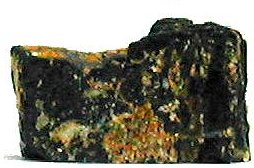
 |
In focus: Tourmaline |
| Chemical Composition: Na(Mg,Fe,Li,Al,Mn)3Al6(BO3)3Si6O18 | |
| Group: Silicate | |
| Colour: Green, White, Pink, Black | |
| Streak: white | |
| Hardness: 7 | |
| Density: 3-3.2 | |
| Luster: Vitreous | |
| Cleavage: None | |
| Acid sensitive: no | |
|
Tourmaline is formed from a complex group of silicate minerals which share an identical (trigonal) crystal structure but which differ chemically. The main components of Toumaline are aluminium and boron silica, but due to isomorphous replacement (the replacement of one ion by another in the crystal lattice without changing the structure of the mineral) other chemicals have been incorporated, mostly sodium, calcium, iron, magnesium and lithium. |
Differences in chemical composition cause a wide range of colours of this mineral from black (the most common) to pink, red, green, blue, yellow and (very rarely) transparent Tourmaline. A high concentration of iron in the stone will result in its being between black and dark blue whereas magnesium-rich Tourmalines are brown to yellow. All coloured Tourmaline gems display pleochroism, meaning that their colour changes when viewed from different angles. In some gems, this effect is hardly noticeable, while in others it is strongly apparent.The name Tourmaline comes from the Sinhalese word turamali which means "attracting ash" and refers to the stone's pyroelectrical properties (it generates electrical potential when heated or cooled) which cause it to attract dust particles. Interestingly, Tourmaline's its pyroelectrical properties have caused the stone to be put to use in cleaning pipes.
Although Toumaline is the generic name for a group of minerals, different gem varieties of this mineral have their own unique names. There are fifteen different varieties of Tourmalines; listed below.
Buergerite: NaFe3Al6B3Si6O30F - was named after Professor Martin J. Buerger, a scientist and crystallographer
Chromdravite: NaMg3[Cr,Fe+3]6B3Si6O27(OH)3(OH,F) - A rare type of tourmaline found in Kenya, Zambia, Namibia and Tanzania. It has a rich green colour caused by the presence of Chromium or Vanadium oxides. It was first mined in Tanzania in the 1960s. This Tourmaline can have the colour of top grade emerald and is much more durable.
Dravite: NaMg3Al6B3Si6O27(OH)3(OH,F) - brown Tourmaline named from the Drave district of Carinthia
Elbaite: Na(Li,Al)3Al6B3Si6O27(OH)3(OH,F) - named after the Italian island of Elba, which can be further subdivided into:
Feruvite: CaFe+23Al6B3Si6O27(OH)3(OH,F) - a dark-brown to black variety. The name is a compound noun made of FER (from ferrum = iron) and uvite because of the similarity to the Tourmaline variety of that name.
Foitite: (Fe+22Al)Al6Si6O18(BO3)3(OH)4 - a dark greenish-black, striated variety. It was discovered by Franklin F. Foit, Jr. (b. 1942), a mineralogist working at Washington State University.
Hydroxy-feruvite: CaFe+32(MgAl5Si6O18(BO3)3(OH)4
Liddicoatite: Ca(Li,Al)3Al6B3Si6O27(OH)3(OH,F) - was named after gemologist Richard T. Liddicoat.
Magnesiofoitite: (Mg2Al)Al6Si6O18(BO3)3(OH)4 - similar in structure to Foitite, with the substitute of iron for magnesium.
Olenite: NaAl3Al6B3Si6O27(OH)3(OH,F) - pink variety found in Oleny Ridge, Russia.
Povondraite: NaFe+33Fe+36B3Si6O27(OH)3(OH,F) - named after Dr. Pavel Povondra from Charles University in Prague. This is a very rare variety of Tourmaline.
Rossmanite: (LiAl2)Al6Si6O18(BO3)3(OH)4 - Tourmaline type originally discovered near Rozna in Czech Republic. It is a litium-rich variety which forms pale pink columnar crystals.
Schorl: Na(Fe,Mn)3Al6B3Si6O27(OH)3(OH,F) - this iron-rich black variety is the most common Tourmaline and accounts for about 95% of the natural sources. It was the first Tourmaline to be described (by Mathesius in 1524). The name comes from old German mining term for gangue minerals (waste minerals or rock with which the economically important minerals occur)
Uvite: CaMg3(Al5Mg)B3Si6O27(OH)3(OH,F) - named after the Uva district in Sri Lanka
Vanadiumdravite: NaMg3V6Si6O18(BO3)3(OH)4 - a dark-green variety similar to Dravite but containing vanadium.
Paraiba Tourmiline is a recently discovered variety (1989). It has also been known as Neon Tourmaline because of its vivid blue and green colour. Paraiba Tourmiline is rare and very valuable and is the only Tourmiline to contain copper. It is mined at the Mina da Bathalha in the Brasilian state of Paraiba, hence the name.
Tourmaline is associated with igneous rocks, in particular granite and granite pegmatite, and in metamorphic rocks such as schist and marble. Pegmatitic Tourmaline is usually black and is associated with albite, quartz, microcline and muscovite. The light colored gem Tourmalines are rarer, usually occurring in pegmatite core zones with quartz, clevelandite, muscovite, lepidolite and more rarely amblygonite and spodumene. Most types of Tourmaline can be found in Brazil and are predominently mined in Minas Gerais and Bahia. Tourmaline is also mined in Tanzania, Kenya, Madagascar, Mozambique, Namibia, Afghanistan, Pakistan, Sri Lanka, and California and Maine in the United States. Californian Tourmalines are known for their perfect pinks and their beautiful bi-colour varieties.
| _______________________________ | ||||
| Home | | | Shopping | | | Database |
© Biscuit Software 2004-2015
All rights reserved